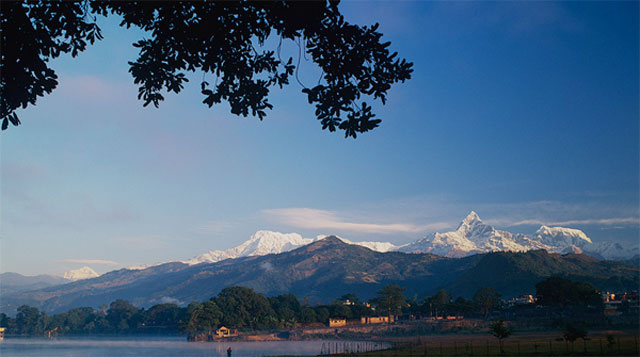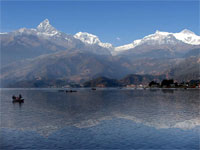
Pokhara sits high on the list of ‘must visit’ places in Nepal. Tourists on extended holidays in Nepal make multiple visits to this famous valley of the seven lakes three lakes being major ones. The tourist district of Pokhara better known as ‘Lakeside Pokhara’ is quite distinctly separate from Pokhara city. Lakeside sprawls beside Phewa Lake and is reminiscent of Thamel except for the ample space and miniscule traffic which makes Pokhara so much more enjoyable and relaxed than its counterpart in Kathmandu. The enchanting Pokhara valley with the dominating presence of Mt. Machhapuchhre (Fishtail Mountain) in the background is the gateway to the Annapurna region where many a trekker finds his Shangri-la. Pokhara is also ideally placed for adventure sports such as: rafting, paragliding and ultra-light flights. The relaxed atmosphere on the shores of Phewa Lake gives a trekker a much needed respite from days of hiking up and down the hills and mountains on one of the popular Annapurna treks. The crowded bars and restaurants are the places to seek companionship, where tall stories and real life experiences are shared with perfect strangers. The friendly Nepalese make a tourist feel at home to the point where many stay on for extended periods and come each year to seek those friends he/she has made and to find peace of mind.
Pokhara’s bewitching beauty has been the subject of many travel writers. Its pristine air, the spectacular backdrop of the snowy peaks, the serene lakes and the surrounding greenery make it ‘the jewel in the Himalaya’, a place of remarkable natural beauty. Mt. Machhapuchhre (6,977 m) has a mesmerizing effect on any nature lover and the Phewa Lake creates an ambience of peace that is magical. Warmer than Kathmandu because of its lower altitude, Pokhara is pleasant in the winter and has a rich flora and fauna making it ideal for bird watching.
Most popular places in Pokhara as follows:
 Pokhara owes its popularity to enchanting Phewa Lake and along its eastern shore has grown the Lakeside town where tourists gather. It is the largest and most beautiful of the three lakes attracting a large number of visitors who enjoy boating on its placid waters. Boat can be hired and many visit the island temple that lies out in the middle of the lake. The other past time is sailing. Lakeside or Baidam, is a thriving resort town of hotels, restaurants, bars and souvenir shops that allow travelers to relax and yet have all they need.
Pokhara owes its popularity to enchanting Phewa Lake and along its eastern shore has grown the Lakeside town where tourists gather. It is the largest and most beautiful of the three lakes attracting a large number of visitors who enjoy boating on its placid waters. Boat can be hired and many visit the island temple that lies out in the middle of the lake. The other past time is sailing. Lakeside or Baidam, is a thriving resort town of hotels, restaurants, bars and souvenir shops that allow travelers to relax and yet have all they need.
Barahi Temple:
 Located in the middle of Phewa Lake, the Barahi temple is the most important monument in Pokhara. The two storied pagoda is dedicated to the boar manifestation of’ Ajima who represents the female force Shakti. Sacrifices take place here and the largest crowds of devotees are seen on Saturdays, the official holiday in Nepal.
Located in the middle of Phewa Lake, the Barahi temple is the most important monument in Pokhara. The two storied pagoda is dedicated to the boar manifestation of’ Ajima who represents the female force Shakti. Sacrifices take place here and the largest crowds of devotees are seen on Saturdays, the official holiday in Nepal.
Seti Gandaki:
An amazing aspect of Pokhara is the vanishing river. A natural wonder, the Seti Gandaki goes underground, vanishing from sight in many places along its route through the city. At various points the river is barely two meters wide where its depth reaches an astonishing 20 meters! A good spot for watching the river below is Mahendra Pul at Bhimsen Chowk, a small bridge near the old Mission Hospital. Here the river can be seen in all its ferocity gushing down the deep gorge that it has carved over millennia.
Davi’s Fall:
 Locally known as the Patale Chhango (Nether Fall), Davi’s Fall is a charming little waterfall located about 2 km south-west of the Pokhara airport on the Siddhartha Highway. Many years ago a trekker named Davi is said to have been washed away by the river Pardi Khola and disappeared in an underground passage beneath the fall.
Locally known as the Patale Chhango (Nether Fall), Davi’s Fall is a charming little waterfall located about 2 km south-west of the Pokhara airport on the Siddhartha Highway. Many years ago a trekker named Davi is said to have been washed away by the river Pardi Khola and disappeared in an underground passage beneath the fall.
Mahendra Cave:
 A major attraction of Pokhara is the Mahendra Gupha, a limestone cave reached after a two-hour walk north of Pokhara. The cave is an interesting labyrinth of stalactites and stalagmites. Visitors will be well-advised to bring their own torches to closely inspect the formations. (there is another cave called Bat’s Cave) Known as the ‘House of Bats’ owing to a number of bats living within its walls,
A major attraction of Pokhara is the Mahendra Gupha, a limestone cave reached after a two-hour walk north of Pokhara. The cave is an interesting labyrinth of stalactites and stalagmites. Visitors will be well-advised to bring their own torches to closely inspect the formations. (there is another cave called Bat’s Cave) Known as the ‘House of Bats’ owing to a number of bats living within its walls,
World Peace Pagoda:
 World Peace Pagoda can be seen on the top of a hill on the southern fringe of Phewa Lake. It has four images of Buddha facing in four directions. The dome shaped pagoda is an impressive sight and its hilltop location commands a great view. It is a great vantage point which offers spectacular views of the Annapurna.
World Peace Pagoda can be seen on the top of a hill on the southern fringe of Phewa Lake. It has four images of Buddha facing in four directions. The dome shaped pagoda is an impressive sight and its hilltop location commands a great view. It is a great vantage point which offers spectacular views of the Annapurna.
The Old Bazaar:
A stark contrast to Lakeside Pokhara, the old Pokhara Bazaar is 4 km away from Phewa Lake. It is a traditional bazaar and a colorful gathering place for an ethnically diverse group of traders. The temples and monuments bear a close resemblance to the Newari architecture of Kathmandu Valley. Except for the large concrete buildings that have cropped up, the market place retains much of its original charm. It makes for a pleasant walk; there are shops selling anything from edibles and clothing to cosmetics and gold. The old bazaar is also home to one of Pokhara’s most important shrines’, the Bindhyabasini Mandir. Perched on a shady hillock, this white dome-like structure dominates a spacious stone-paved courtyard.
Museums:
The Pokhara Museum is worth a visit. Located between the bus stop and Mahendra Pul, it showcases the ethnic mosaic of the diverse cultures that thrive in western Nepal. The lifestyles and history of the Gurungs, Thakalis and Tharus are attractively represented by models, photographs and artifacts. Of much interest and also a major attraction is the recently discovered remains of an 8000-year-old settlement in Mustang. It opens daily from 10 am to 5 pm, except on Tuesdays and public holidays.
Another interesting museum in Pokhara is the Annapurna Regional Museum which is also known as the Natural History Museum. Run by the Annapurna Conservation Area Project (ACAP), the museum has an exceptional collection of butterflies, insects, birds and models of wildlife found in the area. Located at Prithvi Narayan Campus, east of the old bazaar, it is open daily from 9 am to 5 pm except on Saturdays and public holidays.
International Mountain Museum:
 The International Mountain Museum (IMM) has an impressive façade. It was built with the objective of recording, documenting, exhibiting and chronicling the entire past up to the present day, the development of mountain and mountaineering activities in the world. It has received much support from many mountaineering clubs and associations as well as individual donors from around the world. The museum was established by Nepal Mountaineering Association (NMA) with the theme ‘Man, Mountain and Mountain activities around the world’. Accordingly, the entire display area of the museum has been divided along the theme
The International Mountain Museum (IMM) has an impressive façade. It was built with the objective of recording, documenting, exhibiting and chronicling the entire past up to the present day, the development of mountain and mountaineering activities in the world. It has received much support from many mountaineering clubs and associations as well as individual donors from around the world. The museum was established by Nepal Mountaineering Association (NMA) with the theme ‘Man, Mountain and Mountain activities around the world’. Accordingly, the entire display area of the museum has been divided along the theme